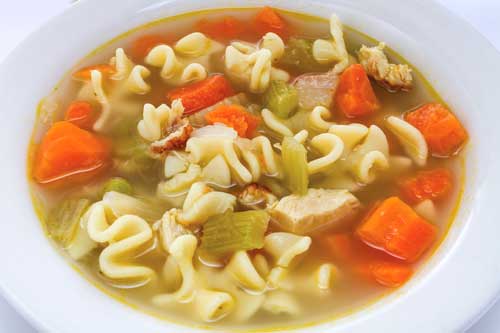Umami boosts likeability; Effect of eating on tasting sessions
NEWS
 Umami boosts likeability of low-sodium foods
Umami boosts likeability of low-sodium foods
Adding umami elements such as monosodium glutamate (MSG) to low-sodium dishes can increase consumer acceptance, according to a recent Journal of Food Science study.
In the study, researchers asked tasters to consume low-sodium chicken noodle soup enhanced with MSG at a concentration of 0.1% to 0.5% alone or in synergy with 5’-ribonucleotides of inosine monophosphate (IMP) at 0.1%. Regardless of concentration, umami-containing soups were perceived as more savory, flavorful, and less bland while providing a more “homemade, fresh, and healthy wholesome taste” than a control sample, according to the researchers. These tasters also reported a significantly higher level of general satisfaction after eating, and they later said they would feel happier serving the soup to family and friends than those who consumed the control. These tasters also reported that the feeling of being healthy while consuming soup that contained MSG and IMP was not compromised.
Takashi Miyaki, an author of the study, suggests that formulators looking to add MSG to foods begin with 0.1%–0.2% of the ingredient in soup products and 0.2% in solid foods such as sausage. “MSG is a self-limiting substance,” he explains. “Once the proper amount is used, adding more contributes little, if anything, to food flavor. Overuse of MSG, as with many other seasonings and spices, may cause some foods to have an undesirable taste.”
He adds that while it is clear that adding MSG provides benefits, it might be hard for some consumers to embrace the ingredient. “Scientific evidence is sometimes very difficult for consumers to understand,” he says. “The important point is to translate the scientific beneficial evidence to an easy, common language for consumers.”
Forecasting the future of food
Growing vegetables inside their homes, using automated shopping programs to restock their pantries, and exploring their own microbiomes are some ways people might interact differently with their food in the future, according to Rebecca Chesney, research and communications manager for the nonprofit Institute for the Future, who spoke at the Winter Fancy Food Show in San Francisco.
Part of Chesney’s organization, the Food Futures Lab, predicts what food might look like in 10 years, and these forecasts are intended to provoke people to think differently. “If this is the future we see, what can you do to thrive in it?” she asked.
Food gardening has experienced a surge in popularity, and that movement will also include growing food inside, said Chesney. Through the Internet, users will be able to share their “recipes” for climate settings, meaning that they won’t need to be experts to grow good food. Additionally, online ordering is already in play, including options such as Amazon’s Dash buttons. Chesney predicted that automated coffeemakers and pet food dispensers could take that a step further, automatically reordering when they sense that supplies are low.
Finally, according to Chesney, people are already interested in how their gut bacteria—their microbiome—affects their health. In the future, people may swallow sensors to track their bacteria and help understand their digestive process, perhaps allowing them to customize their diet to best suit it.
Effects of eating before tasting sessions
A new study that appeared in the Journal of Food Science explored how the foods and beverages that sensory evaluation participants ate and drank before their tasting sessions affected their perceptions of sour, sweet, salty, and bitter tastes.
While participants are generally asked to abstain from food and beverages for 30 minutes before completing a test, investigators cannot be sure panelists have complied. This study sought to determine how the consumption of several items—coffee, orange juice, and gum—given at 1, 15, or 30 minutes before the test affected panelists’ interpretations of these four tastes.
When compared to water, mean intensities of all tastes were not significantly different when orange juice was a primer, but mean intensities of bitter were significantly lower when coffee was a primer and mean intensities of sweet were significantly lower when gum was a primer. According to the authors, the findings showed that it is necessary for panelists to eschew foods and beverages at least 30 minutes prior to sensory testing.
--- PAGE BREAK ---
Food safety for marijuana-infused edibles
Anyone creating marijuana-infused edibles had better understand the FDA’s rules and regulations governing food and beverage items, especially as more and more states legalize marijuana, according to a Food & Drug Law Institute webinar about marijuana regulation in the food and drug area.
With marijuana already legal in several states, 2016 will likely see legalization expand further, according to Jordan Wellington, director of compliance at specialty law firm Vicente Sederberg, and Robert A. Hendricks, an attorney with Wrigley, Hoffman & Hendricks. They explained that these changes will likely result in an increasing number of new businesses producing edibles. While edibles sold in these states are not considered “food” and regulated by the FDA, that doesn’t mean these products are immune to food safety issues, said Wellington. “As far as I know, cannabis is not an antiseptic,” he said.
While production oversight requirements differ from state to state, if they are required at all, it is in companies’ interests to employ good manufacturing practices, adhere to food safety requirements under the Food Safety Modernization Act, adopt a HACCP plan, and maintain good records, said Troy D. McMahan, partner at international litigation and business law firm Sedgwick. He also emphasized the importance of aligning production practices with the state-specific requirements for manufacturing, labeling, and dosage.
 Graphics help eaters choose better foods
Graphics help eaters choose better foods
Consumers who are shown a graphical display of select nutrients when ordering in a café setting purchase healthier menu items, according to a new study from the University of Illinois.
“Current nutrition labels provide comprehensive nutrient information, but unfortunately they’re not working for consumers to help them make decisions in restaurants and grocery stores,” says Manabu T. Nakamura, an associate professor of nutrition.
In the study, researchers created a visual, two-dimensional plot showing the values of fiber and protein per calorie—nutrients closely tied to weight management—for menu items. Recall accuracy of this information improved by up to 43% when participants were shown the information graphically versus numerically. In a second experiment, diners were shown nutritional information in either the graphic or numerical list in a real café setting. When nutrition information was provided in graphic form, consumers purchased fewer calories and purchased items with more protein per calorie.
“This may be the first study that shows unambiguous purchasing changes from displaying the nutrition information,” says Nakamura.
News Bites
• AAK USA received the 2015 Natural Products Assoc. Industry Champion Award.
• The American Assoc. of Candy Technologists is offering a $5,000 scholarship for the 2016–2017 academic year. The application deadline is April 1; click here to apply.
• BENEO announced that the EU Commission authorized a 13.5 health claim with proprietary use for its chicory root fiber inulin promoting digestive health.
• Campbell Soup announced that it will begin disclosing the presence of genetically engineered ingredients like corn, soy, and sugar beets in its products.
• ConAgra Foods committed to use 100% cage-free eggs in its U.S. products by 2025.
• Frutarom acquired Grow Co. in order to expand its natural solutions portfolio.
• General Mills acquired EPIC Provisions, a premium meat snacks company based in Austin, Texas.
• Hawkins acquired Stauber Performance Ingredients from ICV Partners II.
• Hinoman introduced a proprietary cultivation process for plant protein that enables water savings of up to 90%.
• The International Wheat Genome Sequencing Consortium reported that the whole genome assembly of bread wheat has been completed.
• Kalsec announced that Shahmeer International would be the company’s new channel partner in the Pakistani food market. It also announced that its Denver City, Texas, plant achieved organic certification from Oregon Tilth Certified Organic.
• NASA food scientist Vicki Kloeris was profiled on Collider.com in an article about the scientists from NASA who helped make the movie The Martian realistic.
• Land O’Lakes Ingredients made several updates to its website, including adding a Request a Sample page and launching a new blog about today’s snack landscape.
• Lawrence Foods achieved an “Excellent” score from the Safe Quality Food Institute during its Safe Quality Food Certification Level 3 audit.
• MGP Ingredients celebrated the 75th anniversary of the company’s founding in 1941.
• Mondelēz International will shut down its Schiller Park, Ill., manufacturing plant, and it committed to sourcing 100% cage-free eggs in the United States and Canada by 2020 and in Europe by 2025.
• The National Assoc. for Business Resources named several food industry companies to its 2015 101 Best and Brightest Companies to Work For list, including Bell Flavors & Fragrances, Edlong Dairy Technologies, and FONA International.
• NSF International acquired the DNA-based testing laboratory AuthenTechnologies, as well as the Burwater Pacific Group, a food safety training, auditing, and consulting business based in New Zealand.
• A Purdue University innovation that creates a fingerprint-like pattern to identify foodborne pathogens without using reagents was licensed by Hettich Lab Technology.
• PURE Bioscience received FDA approval to use its silver dihydrogen citrate antimicrobial as a fresh produce processing aid to combat foodborne illness and reduce pathogens, including Salmonella, E. coli, and Listeria.
• Joseph Sebranek, distinguished professor of animal science at Iowa State University, received the North American Meat Institute’s Harry L. Rudnick Educator’s Award in recognition of his role as an educator of future industry leaders and his extensive research.
• John H. Silliker, the late founder of Silliker Laboratories, was named a 2016 inductee of the National Inventors Hall of Fame.
• Sunny Delight Beverages Co. was acquired by Brynwood Partners VII L.P., which also owns the Harvest Hill Beverage Co.
• zuChem entered into a multiyear process development, commercial product supply, and marketing agreement with Qianyan Alloy Materials for the rare sugar building block l-fucose.
 Melanie Zanoza Bartelme, Associate Editor
Melanie Zanoza Bartelme, Associate Editor
[email protected]
